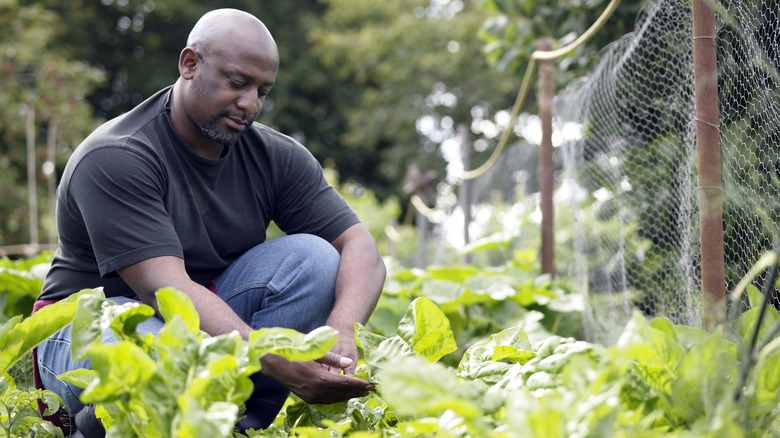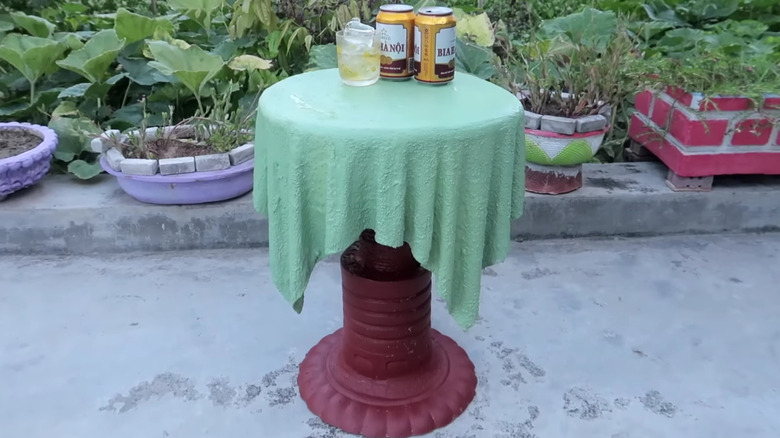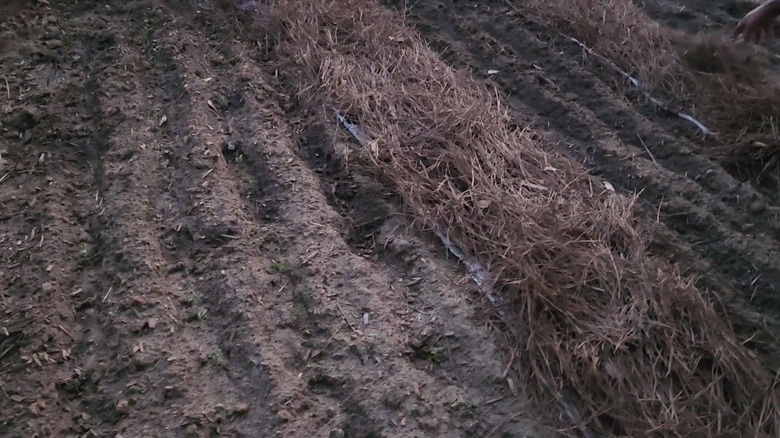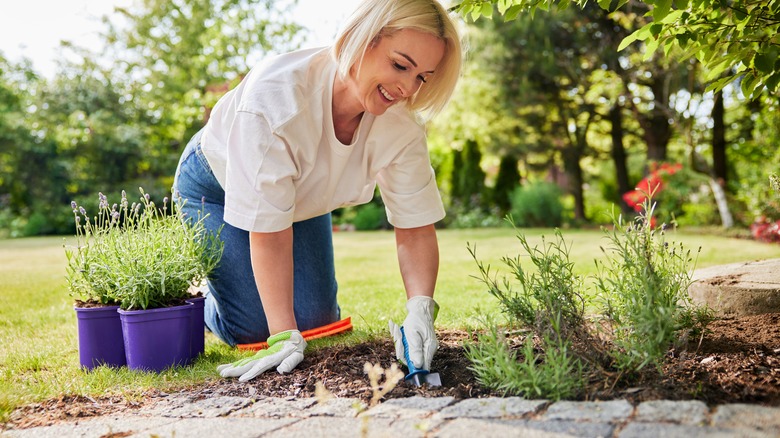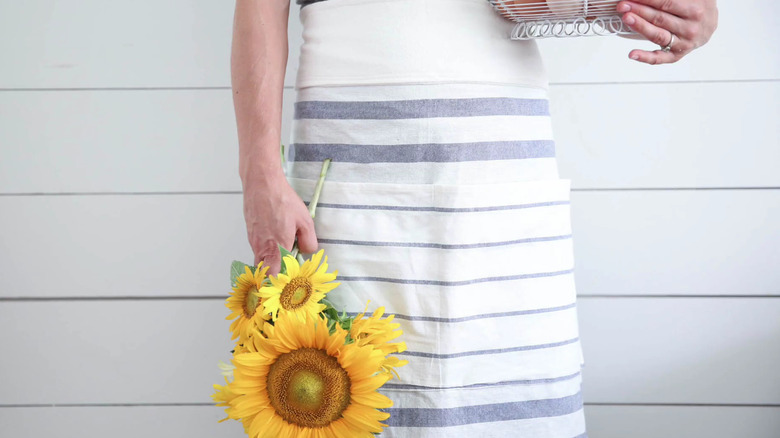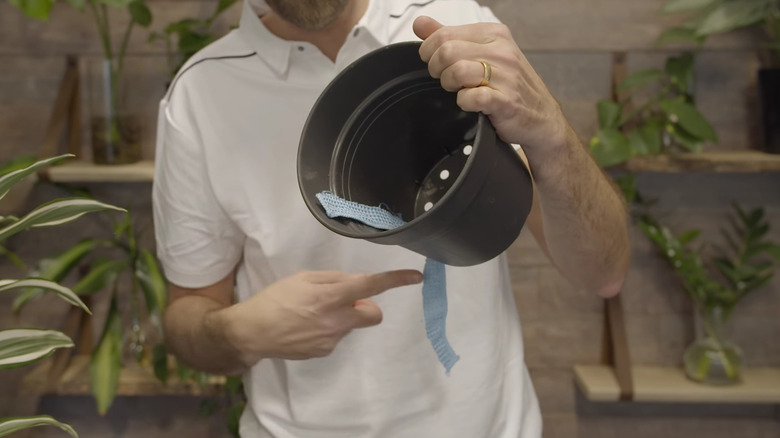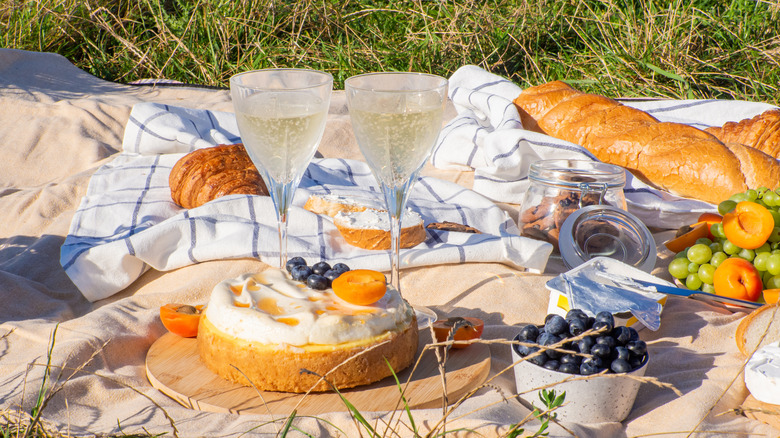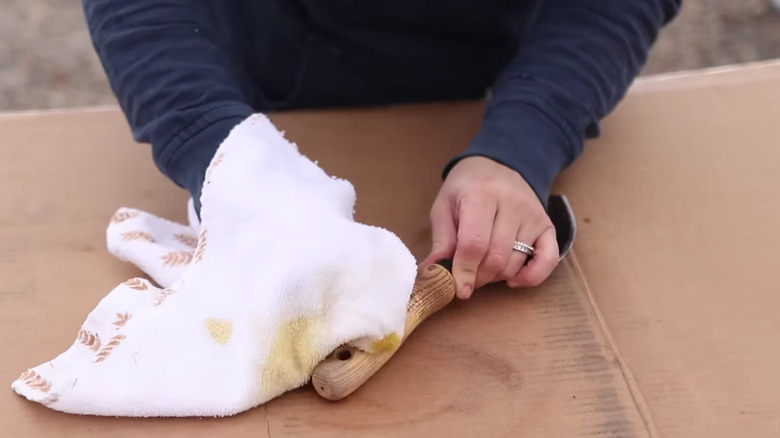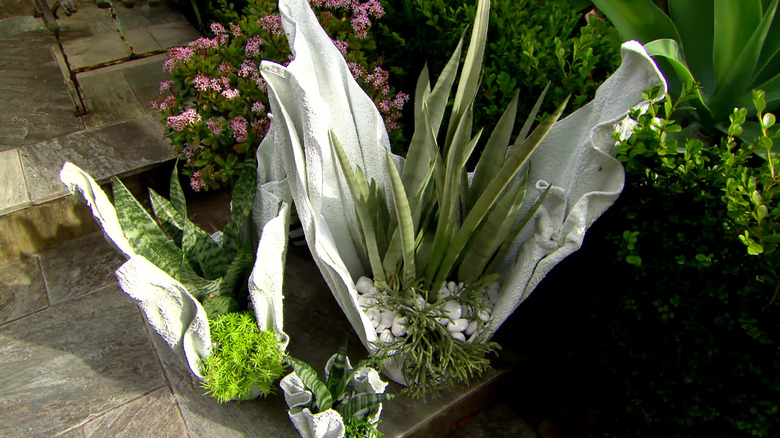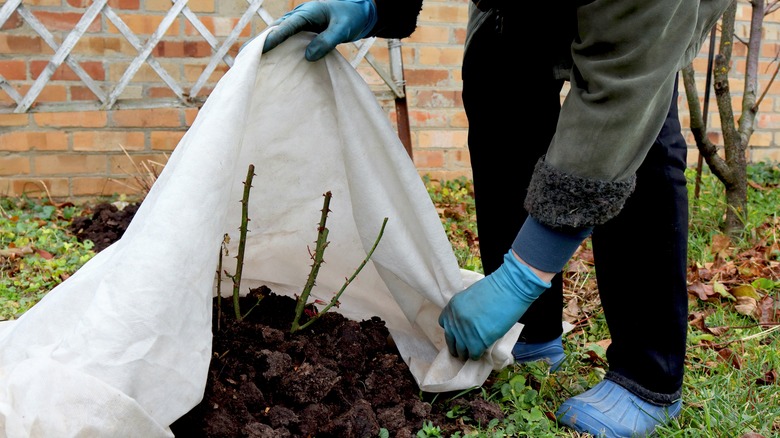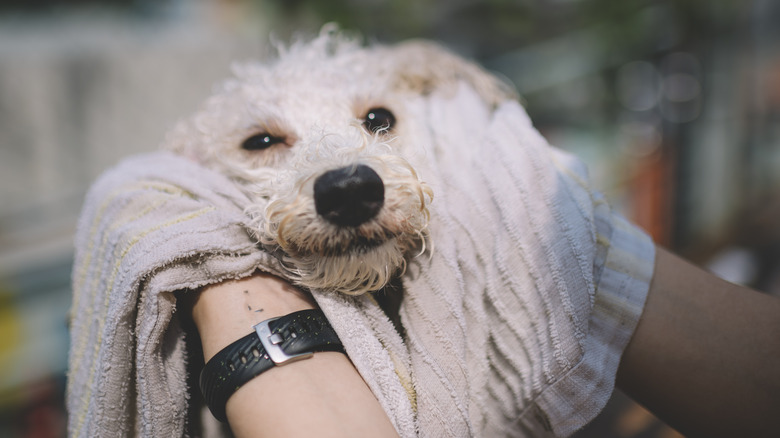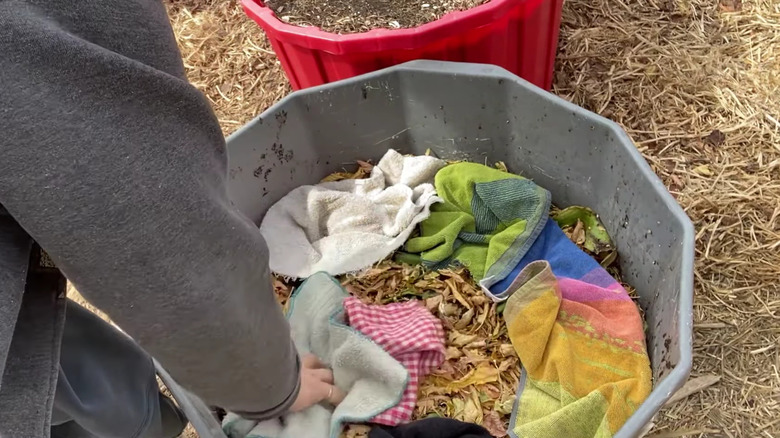11 Genius Ways To Reuse An Old Towel In Your Backyard And Garden
We may receive a commission on purchases made from links.
Is your linen closet piled high with a teetering tower of tired and tatty towels? Your first port of call should be to restore any stained articles to their former glory with the simplest method for stripping your towels, but any that can't be salvaged shouldn't be thrown into the dumpster just yet. There are plenty of clever tips and DIY hacks that can prevent your old towels from ending up in the landfill while simultaneously saving you money.
You might be surprised to learn that worn-out bathroom towels can be repurposed as landscaping material that will hold weeds at bay, used to help keep your plants alive when you're on vacation, and even upcycled into new planters that add a unique and artsy aesthetic to your yard. Here we share some of the most helpful and interesting ways you can utilize any worse-for-wear towels in your backyard and garden.
Create a DIY garden side table
Whether you want a garden side table as a spot to set down your morning coffee or a place for keeping your latest paperback, it's safe to say these small pieces of furniture always come in handy throughout the warmer months. Buying a side table for the garden isn't necessary if you've got some old towels and a few additional items that can be used to DIY a new and completely unique piece. In this tutorial from 93T&T Garden on YouTube, an old towel dipped in wet cement forms the tabletop, while a large serving dish, a plastic bottle, some rope, and a short length of plastic pipe are upcycled to become the central support for the garden table.
Ready to learn about this DIY outdoor furniture project you can start right now? First, you'll want to cut your towel into a square shape so the final tabletop is visually balanced and symmetrical. Create a round mold using a large bucket and a piece of cardboard cut to the size you want the tabletop to be. Combine some cement powder with water to create a sloppy mix, dip the towel into it, then lay the towel over your bucket mold so the edges are hanging down. Allow the towel to dry and set, then remove the mold. Next, you'll need to create a base for the table. Try repurposing old plastic bottles along with more cement, or use offcuts of wood you have left over from other projects to form the pedestal leg of the table.
Make a weed barrier with worn-out towels
Towels that have seen better days can also be utilized in the garden as weed barriers. This is a practice encouraged by Avis Licht, a landscaper in California. She writes on her blog, "The weed barriers that I like to use the most are cardboard, old sheets, towels and blankets, and even old rugs. Most people are shocked when I tell them my paths are covered in old sheets. These materials definitely keep the weeds from growing, but they are also biodegradable and will eventually go back into the soil. This means they don't last forever, but they're free, garden-worthy, and will improve your garden, not harm it."
If you've been trying to find a way to get rid of weeds in your garden that isn't going to be harmful to the environment, then consider using old towels as a chemical-free alternative that won't cost you a dime. Towels are quite thick, so they prevent sunlight from reaching weeds and encouraging them to grow, and their weight can also help to smother the weed seedlings and keep them from emerging out of the soil. For large flowerbeds with a good amount of soil to cover, lay your tired towels directly on the surface of the ground. Weigh large towels down with gravel, straw, wood chips, or use ground stakes like these from Amazon to prevent them from moving. For smaller areas, you can also shred your towels into rags and lay the strips in between plants to prevent unwanted weeds from making an appearance.
Protect your joints when gardening with a makeshift kneeling pad
Gardening is an enjoyable pastime for most plant enthusiasts, but that doesn't mean it's comfortable. Hours spent kneeling on the ground can wreak havoc with your joints so it's always beneficial to have some sort of cushioning under your knees to protect them. Gardening expert Craig Morley tells Woman & Home, "Although you can buy knee pads to use when you are gardening, you can easily make your own with old towels. Simply fold the towel over several times until you have reached the desired thickness required to support your knees."
Next time you plan to spend time on the ground planting garden bulbs or weeding around shrubbery, refrain from reaching for a cushion, which is bound to get muddy and ruined. Instead, save old towels and store them in your shed or garage precisely for this purpose. Towels can be folded up into rectangles that are just the right size to accommodate both of your knees, providing comfort to your joints when knelt on. As they are absorbent, towels will also soak up any moisture in the ground and prevent it from seeping through to your clothing.
Upcycle tired tea towels into a harvest apron
Stained or old tea towels can also be repurposed in the garden, with the addition of a reel of cotton and some basic sewing skills. You can utilize old tea towels to create a new harvest apron for collecting fruits, seeds, or flowers from the garden. This YouTube tutorial by Farmhouse on Boone uses two new Ikea tea towels, but old or slightly worn tea towels will work just as well.
Old tea towels are great for making harvest aprons because they are a hardwearing material that will stand up well against rough use in the garden. They are also absorbent which means less of the moisture from the fruits or flowers you're harvesting will seep through to your clothing. To DIY a harvest apron from old tea towels, you'll need a sewing machine and a spare ten minutes, or if you're sewing by hand, you can expect to need at least an hour. Lay two tea towels together to create a large pocket and stitch the edges to secure them in place. Add further vertical lines of stitching if you want to create smaller pockets to gather seeds from late summer annuals to plant next year. Attach a ribbon to the top of the apron to form the waistband.
Drip feed potted plants when you're away
Returning home from a vacation to find that your potted plants have all died is probably not the kind of welcome party you were hoping for. Next time you're heading off on your travels, remember to set up a few towels as a drip feed system to keep your thirsty potted plants content until you return. Ruth Hayes, gardening editor of Amateur Gardening magazine, explains to Gardeningetc, "Simply fill a bucket with water and tear an old towel into strips. Put one end of the strip into the water and bury the other just under compost in the pots you want to water. Voilà! This is a very basic capillary watering system and is good for when you go on holidays."
If left for days or weeks without water, plants growing directly in the ground have a better chance of survival because their roots can dive deep into the soil to find moisture. Garden beds are slower to dry out than soil in pot plants. Unfortunately, this means plants in containers are usually the first to wither if they're not being watered in dry weather. The absorbent nature of towels makes them are ideal for cutting into rags and gradually transferring moisture from a bucket of water to the soil of a potted plant. You can thread a strip of towel through the drainage holes in a pot before planting, or drape it over the rim. You can also use string or this simple shoelaces hack to make sure plants stay watered if your supply of old towels is getting low with all these great upcycling ideas.
Oversized old towels can double up as garden picnic blankets
Splashing out a fortune on fancy picnic blankets that are bound to get muddy or covered in crumbs might not be the best use of your hard-earned cash, but that doesn't mean you can't enjoy a garden picnic with friends and family. Sew together scraps of old towels to make a custom patchwork picnic blanket, or if sewing isn't your thing, simply use oversized old towels laid out on the lawn as a comfortable spot to enjoy some sandwiches in fair weather.
Old towels make a great picnic blanket substitute because they are thick and absorbent, so any remnants of moisture on your lawn won't transfer through to your clothing when you're sat down on the grass with an iced tea, or lazing back with a good book. Since picnic blankets spend most of their time on the ground and ultimately get stained with ground or grass, using towels that are already past their best will eliminate any concerns you have about soiling.
Keep dirty garden tools dry and in pristine condition
Dan Cooper, a specialist tool supplier, suggests keeping old towels handy in the garden to extend the lifespan of your equipment. He tells The Middle Sized Garden, "The number one enemy of your garden tools is water and being wet. Never leave forks, trowels, and spades outside ... The damp causes metal to rust and wooden handles to swell up." Cooper also explains that "it's absolutely imperative that garden tools are dry when you put them away. That's really all you need to do to maintain garden tools after using them every day."
Good-quality garden tools can last for decades if you take proper care of them. Most gardeners know not to leave tools out in the rain, but did you know that leaving remnants of mud on your metal implements can also be a source of issues? The moisture content in soil clumps can be enough to cause rust to form on garden tools, which in turn will limit their expected lifespan. Old towels are ideal for wiping down trowels and spades after use because they are soft and absorbent. Keep a stock of worn-out towels in your garden shed or garage near your tool supply so that you'll always have one to hand when needed.
Make stunning plant pots using tatty towels and cement
There are many household items you can repurpose into DIY garden planters, but towels are probably not something you'd expect to make it onto this list. However, towels, when combined with cement, can be used to make original and unique planters that can be shaped however you like. These stylish planters can be created in any size, and they double up as garden artwork worthy of any sculpture gallery. Jason Hodges from Great Home Ideas shares via YouTube how he makes garden planters using towels and concrete. He says, "What we're going to do is drape our dirty old towels over the pots, set them in cement, turn them back over the other side in a day or two, and you will have the most unusual shapes."
The draping quality of towels means they can be used to create flared, fluted shapes when dipped in cement, which will then harden. Hodges recommends mixing neat cement powder with water until it reaches a consistency in between toothpaste and pancake batter. Remember to wear gloves to protect your skin, then dunk the towels into the cement and make sure they are thoroughly coated before positioning them over plastic plant pots piled high. Allow the cement to dry, and then remove the plant pots. Drill drainage holes into the base of your new cement planters and spray paint them if you wish. You can also use cement oxide to change the color.
Protect plants from winter frost
If you have warm-weather perennials growing in your garden that require protection from dropping winter temperatures, you'll need to know some tips for protecting your plants from frost. Plants kept in pots can be brought indoors for overwintering, but those growing directly in the soil don't have the benefit of being portable. To save unnecessary spending, Russell Birchell, the founder of Hedging UK, suggests using old items you already have around the home to protect plants that need to be overwintered in the garden. He tells Woman & Home, "I recommend using old towels to protect your plants from frost. This can be achieved by draping the old towels over any delicate plants during particularly cold nights. The towels act as insulators, retaining heat while shielding your plants from frost damage."
Towels are thick enough to keep the cold out when they're wrapped around tender plants, making them an ideal material for preventing frost damage. If plants are dormant, they don't need sunlight through the winter and can be kept under towels all season long until the warmer weather returns. If the plants are not dormant, remember to remove the towels during daylight hours.
Prevent muddy paw prints from getting inside your home
Spending time outdoors with your pooch can be one of the most enjoyable parts of owning a dog, but constantly cleaning up muddy pawprints certainly isn't. One of the cleaning tips pet owners should live by is wiping down mucky paws before they have the opportunity to run across your sparkling floors. Lynsey Crombie, the "Queen of Clean" and best-selling author of several cleaning guide books, tells Belfast Live that you can set up a doggy cleaning area at the entryway of your home so they can have their paws washed after each trip outside. She advises, "Leave a bowl of water and some old towels by the door, or use your outside tap with a hose."
Using perfectly good towels to wipe down muddy paws will quickly transform them into stained, ruined rags. Instead, utilize absorbent old towels that are already past their best to wipe away mud and moisture from your pet's paws. Fold up a pile and store them in a cupboard by your back door, or set a basket for towels by the entryway so you can easily grab one just as you arrive home with your furry friend. This can also be a good way to wipe down dogs after they've been in the garden during wet weather.
Save water by putting old towels in the base of planters
Old towels are one of the unexpected items you can add to the bottom of your planters. Steve Chilton, gardening expert, educator, and director of LeisureBench, recommends filling the base of planters with old towels to save water. He explains to Ideal Home, "Place old towels in the bottom of large pots or containers before you add any soil and plants. This will help retain moisture in the container, reducing the frequency of watering needed, especially during hot summer days when the weather is more extreme."
The absorbent nature of towels means they can be used to create a slow-release, in-built watering system in outdoor planters and containers. They will hold on to rainwater and transfer it to the roots of the plants when needed. Less watering will be required during warm weather, which is better for the environment, and in turn, will help to reduce your water bill. Filling the base of planters with old towels will also allow plants to go longer between watering, which can be useful if you're away from home and don't want your plants to die. In larger planters, filling the pot base with old towels also means you don't need to use as much soil, which can save some money at the gardening center.
